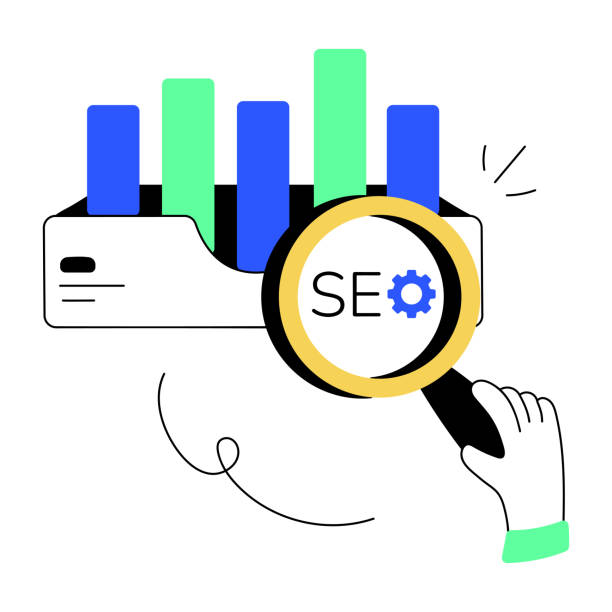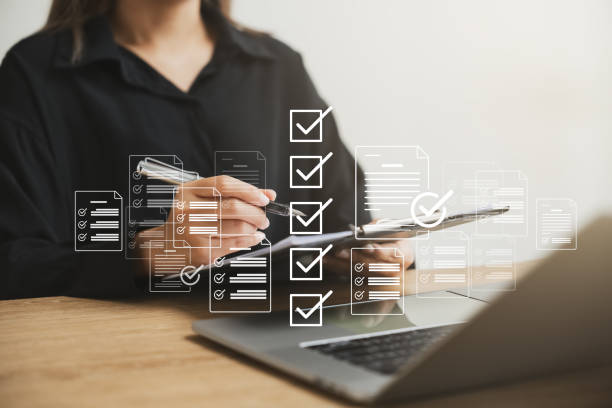What is On-Page SEO and Why is it Important?

On-Page SEO refers to a set of techniques and actions performed within a website and its pages to improve its ranking in search engines like Google.
These techniques include optimizing content, site structure, HTML tags, and other factors that help search engines better understand the site’s content and display it to relevant users.
The importance of On-Page SEO stems from the fact that search engines aim to provide their users with the best and most relevant results.
By optimizing internally, you show search engines that your site is a valuable and credible resource.
This leads to an increase in site ranking in search results, attracts more traffic, and ultimately boosts sales and revenue.
In fact, On-Page SEO is the foundation of a successful SEO strategy, and without it, efforts in Off-Page SEO alone will not be sufficient.
With a correct #SEO strategy, businesses can appear on the first page of Google.
In summary, On-Page SEO helps you to:
- Increase your site’s ranking in search engines.
- Attract more traffic to your site.
- Provide a better user experience for visitors.
- Gain more credibility and trust among users and search engines.
Are you dissatisfied with your e-commerce site’s low sales?
Rasaweb is your solution for having a professional and high-selling e-commerce site.
✅ Significant increase in sales and revenue
✅ Easy and enjoyable shopping experience for customers
⚡ Get free consultation from Rasaweb now!
Keyword Research and Its Role in On-Page SEO

Keyword research is the cornerstone of any successful On-Page SEO strategy.
Choosing the right keywords helps you optimize your content based on users’ needs and searches.
This ensures that your site appears in relevant search results and attracts more targeted traffic.
The keyword research process involves identifying words and phrases that users employ to find information, products, or services related to your business on search engines.
These keywords should be relevant, high-volume, and low-competition to increase your chances of ranking high.
Using tools such as Ahrefs, Moz Keyword Explorer, and Google Keyword Planner can be very helpful in this process.
After identifying keywords, you should strategically use them in your content.
This includes using keywords in the page title, meta descriptions, subheadings, body text, and image tags.
However, you should avoid excessive keyword usage (Keyword Stuffing), as this can harm your site’s ranking.
Ultimately, keyword research is an ongoing process.
You should regularly review and update your keywords to stay aware of changes in user search behavior and search engine algorithms.
Optimizing Page Content for On-Page SEO

Content is King! This phrase is very famous in the world of On-Page SEO and indicates the high importance of content in website rankings.
High-quality, valuable, and relevant content can attract a lot of traffic to your site and keep users on the site for longer.
To optimize page content for On-Page SEO, you should pay attention to the following points:
- Provide valuable and relevant content: Your content should address users’ needs and questions and provide them with useful information.
- Use keywords: Naturally and strategically use keywords in the page title, meta descriptions, subheadings, and body text.
- Optimize images: Describe images using alt text and reduce their size to increase page loading speed.
- Use internal and external links: Internal links help users navigate your site, and external links to reputable sites increase your content’s credibility.
- Regularly update content: Regularly review and update your content to add new and relevant information.
Additionally, you should also pay attention to the structure of your content.
Your content should be readable, well-organized, and have appropriate subheadings so users can easily find the information they need.
| Element | Importance in On-Page SEO | Description |
|---|---|---|
| Page Title | Very High | Must include the main keyword and be attractive and captivating. |
| Meta Description | High | Must provide a brief and compelling description of the page content and encourage users to click. |
| Subheadings | Medium | Should define the content structure and include relevant keywords. |
| Image Alt Text | Medium | Should accurately describe images and include relevant keywords. |
Optimizing HTML Tags for On-Page SEO

HTML tags play an important role in On-Page SEO.
These tags help search engines better understand the structure and content of your pages.
Optimizing HTML tags can help improve your site’s ranking in search results.
The most important HTML tags for On-Page SEO include:
- Title Tag: The title tag is the most important HTML tag for SEO.
This tag is displayed in the browser’s title bar and in search results.
The title tag should include the page’s main keyword and be attractive and captivating. - Meta Description Tag: The meta description tag provides a summary of the page’s content.
This tag is displayed in search results below the page title.
The meta description tag should be attractive and compelling, encouraging users to click. - Heading Tags (H1-H6): Heading tags are used to organize content and create structure on pages.
The H1 tag is the most important heading tag and should include the page’s main keyword. - Alt Text Tag: The alt text tag is used to describe images.
This tag helps search engines understand the content of images.
To optimize HTML tags, you should pay attention to the following points:
- Use relevant keywords in your tags.
- Make your tags unique and engaging.
- Keep the length of your tags within an appropriate range.
Tired of losing customers due to poor e-commerce website design? With Rasaweb, solve this problem forever!
✅ Increase sales and visitor-to-customer conversion rate
✅ Smooth and engaging user experience for your customers⚡ Get Free Consultation
Improving Page Load Speed
![]()
Page load speed is one of the important factors in On-Page SEO and user experience.
Users expect web pages to load quickly.
If a page takes too long to load, users may leave the site and go to other sites.
This can harm your site’s ranking in search results.
To improve page load speed, you can take the following actions:
- Optimize images: Optimize images by using appropriate formats (such as JPEG or WebP) and reducing their file size.
- Compress files: Compress CSS and JavaScript files to reduce their size.
- Use a CDN: Use a Content Delivery Network (CDN) to host your static files.
- Enable caching: Enable browser caching so that web pages load faster on subsequent visits.
- Optimize code: Optimize your HTML, CSS, and JavaScript code to reduce its size.
Tools such as Google PageSpeed Insights and GTmetrix can help you identify and resolve page load speed issues.
Responsive Design and Mobile Compatibility

Today, a significant portion of web traffic comes from mobile devices.
Therefore, responsive design and mobile compatibility are very important for On-Page SEO.
A responsive website automatically adapts to the screen size of the user’s device, providing a better user experience.
Google also places great importance on responsive websites and prioritizes them in search results.
Therefore, if your site is not responsive, you should make it responsive as soon as possible.
To check your site’s mobile compatibility, you can use Google’s Mobile-Friendly Test tool.
In addition to responsive design, you should also pay attention to the following:
- Mobile page load speed: Mobile page load speed should be optimized.
- Use readable fonts: Use readable fonts with appropriate sizes for mobile devices.
- Easy navigation design: Site navigation should be easy on mobile devices.
- Avoid using Flash: Refrain from using Flash on your site, as Flash is not supported on mobile devices.
Proper URL Structure and its Impact on On-Page SEO
![]()
URL structure plays an important role in On-Page SEO.
URLs should be short, descriptive, and include relevant keywords.
A good URL helps search engines better understand the page’s content and shows users what the page is about.
The best practice for constructing URLs is to use a hierarchical structure.
This means that URLs should reflect your site’s structure.
For example, if you have a page about “SEO training”, its URL could be as follows:
www.example.com/blog/amoozesh-seo
In this URL, the keyword “SEO training” is present in the URL, and the URL reflects the site’s structure (the page is in the blog section).
Furthermore, you should avoid using special characters and spaces in URLs.
Instead of spaces, use hyphens (-).
| Feature | Description | Example |
|---|---|---|
| Short and descriptive | The URL should briefly describe the page content. | /blog/seo-internal |
| Use of keywords | The URL should include keywords relevant to the page content. | /products/mobile-phone |
| Hierarchical structure | The URL should reflect the site’s structure. | /blog/seo/seo-internal |
| Use of hyphens | Hyphens (-) should be used instead of spaces. | /about-us |
Finally, ensure that your site’s URLs are consistent.
If you change a page’s URL, use a 301 redirect to guide users and search engines to the new URL.
Internal Linking and Creating a Proper Site Structure

Internal linking refers to the process of linking from one page to another within the same website.
Internal linking plays a significant role in On-Page SEO.
These links help search engines better understand your site’s structure and enable users to easily navigate your site.
To create a proper site structure and improve internal linking, you can take the following actions:
- Create a hierarchical structure: Organize your site hierarchically.
This means that main pages should link to sub-pages, and sub-pages should link back to main pages. - Use descriptive anchor text: Use descriptive anchor text when linking to other pages.
Anchor text is the visible, clickable text in a hyperlink.
The anchor text should be relevant to the content of the linked page. - Link to related pages: Link related pages to each other.
This helps search engines understand the connections between your pages. - Create a sitemap: Create a sitemap and submit it to search engines.
A sitemap helps search engines find all the pages on your site.
Internal linking not only helps with On-Page SEO but also improves user experience.
By linking to relevant pages, you help users easily find the information they need.
Did you know that your company’s website is the first point of contact for 75% of potential customers?
Your website is the face of your brand. With **Rasaweb**’s corporate website design services, build an online presence that earns customer trust.
✅ Create a professional and lasting image for your brand
✅ Attract target customers and increase online credibility
⚡ Get free consultation from **Rasaweb** experts!
Using Structured Data (Schema Markup)

Structured Data (Schema Markup) is code added to web pages to help search engines better understand the page’s content.
Structured data can provide search engines with information about the content type, author, publication date, rating, and more.
Using structured data can help improve your site’s ranking in search results and increase the click-through rate (CTR).
When search engines better understand your page’s content, they can display it more accurately in search results.
This can lead to an increase in CTR, as users are more likely to click on results that are relevant to their needs.
There are various types of structured data you can use.
Some of the most common types of structured data include:
- Article: For news articles, blog posts, and other text content.
- Product: For product pages on e-commerce sites.
- Recipe: For recipe pages.
- Event: For event pages.
- Review: For review pages.
To add structured data to your pages, you can use Google’s Schema Markup Generator tool.
Structured data has a significant impact on improving #SEO and allows Google bots to better understand the site’s content and display it on the results page with better comprehension.
This leads to an improvement in the site’s ranking.
Monitoring and Analyzing On-Page SEO Performance

Monitoring and analyzing On-Page SEO performance is essential to ensure your strategy is effective.
By monitoring and analyzing performance, you can identify the strengths and weaknesses of your strategy and implement the necessary changes to improve results.
To monitor and analyze On-Page SEO performance, you can use various tools such as Google Analytics and Google Search Console.
These tools provide valuable information about site traffic, keyword rankings, site errors, and more.
Some of the most important metrics you should monitor include:
- Organic traffic: The amount of traffic that comes to your site from search engines.
- Keyword rankings: Your site’s ranking for various keywords.
- Click-Through Rate (CTR): The percentage of users who click on your site after seeing it in search results.
- Bounce Rate: The percentage of users who leave your site immediately after entering it.
- Time on site: The average time users spend on your site.
By analyzing these metrics, you can understand which pages of your site are performing well and which pages need improvement.
For example, if you notice that a page has a high bounce rate, you can improve the page’s content or change its design to keep users on the site for longer.
Overall, On-Page SEO is a continuous process that requires effort and commitment.
By following the tips mentioned in this article and monitoring and analyzing your site’s performance, you can improve your site’s ranking in search engines and attract more traffic to your site.
Don’t forget that On-Page SEO is a long-term investment, and its results appear over time.
For more information about SEO, you can visit the Example SEO website.
Frequently Asked Questions
| Question | Answer |
|---|---|
| What is On-Page SEO? | It refers to a set of actions performed within a website to improve its ranking in search engines. |
| Why is On-Page SEO important? | Because it helps search engines better understand your site’s content and structure and improves user experience. |
| What are the most important elements of On-Page SEO? | Title and meta description, keywords, URL structure, quality content, image optimization, internal linking, and site speed. |
| How to optimize Title Tag and Meta Description? | The title should include the main keyword and be attractive, and the meta description should be a compelling summary of the content with relevant keywords. |
| What is the role of keywords in On-Page SEO? | Keywords help search engines understand what the page content is about and should be used naturally and intelligently within the text. |
| How is image optimization done for On-Page SEO? | By compressing their size, using descriptive file names, and filling the Alt tag with relevant descriptions and keywords. |
| What is Internal Linking and what is its use? | It is the connection of different pages of the site to each other. This helps distribute Page Authority and improve search engine crawling. |
| What is the importance of site loading speed in On-Page SEO? | High speed improves user experience and is one of the important ranking factors for search engines like Google. |
| What impact does site responsiveness (Mobile-Friendliness) have on On-Page SEO? | Given the increase in mobile users, responsiveness is essential for providing a suitable user experience across all devices and for Google’s mobile-first indexing priority. |
| What are the important content-related factors in On-Page SEO? | Originality, quality, comprehensiveness, readability, proper use of headings (H1, H2,…), and regular content updates. |
And other services of Rasa Web Advertising Agency in the field of advertising
- Smart Digital Branding: Professional optimization to increase click-through rates by customizing the user experience.
- Smart Social Media: Revolutionize campaign management with the help of key page optimization.
- Smart Social Media: A creative platform to improve sales growth by precisely targeting the audience.
- Smart Direct Marketing: An effective tool for analyzing customer behavior with the help of intelligent data analysis.
- Smart Marketplace: A professional solution to increase website traffic by focusing on attractive user interface design.
And hundreds of other services in the field of internet advertising, advertising consultation, and organizational solutions
Internet Advertising | Advertising Strategy | Advertorial
References
Complete Internal SEO Training
Key Tips for Internal Website Optimization
Internal SEO Checklist for WordPress
On-Page SEO Articles on Moz
? Is your business ready to leap into the digital world? Rasaweb Afarin Digital Marketing Agency, by offering comprehensive services including advanced e-commerce website design, professional SEO optimization, and effective social media strategies, paves your path to online success. For more information and expert consultation, contact us.
📍 Tehran, Mirdamad Street, next to Bank Markazi, Kazerun Jonubi Alley, Ramin Alley, No. 6



